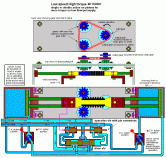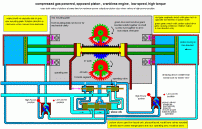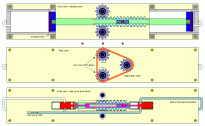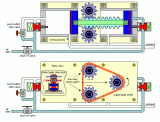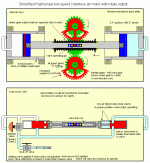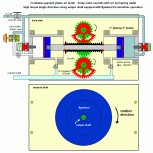|
Slow speed reciprocating air motor
with high torque rotary output
This is a very simple air motor that will operate with a small air supply as it will keep going in each direction untill the pistons reach the full travel on each end. Each piston has pressure on one side when moving and doubles the output power.
The design is based on an air powered diaphram type water pump was used back when I was in the Navy when we where in the shipyard. I searched the net and finally found a simple diagram of the valve system that the pump used. I think the company probably has it patented so if you want one, you’ll have to go to them and talk them into building this system.
It is actually a very simple double acting pump setup but the way that the valves operate forces the the pistons to move with full travel on each stroke. This redesigned motor system uses opposed double acting pictons instead of diaphrams like the original pump. This allows a half gear to operate with two gear racks to give the output shaft a single continous direction of rotation as long as the pistons are moving. The slow speed description does not mean only a few rpm a minute. This setup should be easily capable of operating at a couple hundred rpm output depending on the size of the pistons, valves, tubing and the amount of compressed air available. It is such a simple setup where the valve system does all the work that it can be scaled up or down as needed for speed or power very easily simply by changing the size of the pistons and gear/rack.
The second version uses the same idea but uses one-way clutches and gears with a chain to feed the output gear. It also show how with 2 3-way valves the system can be used with a single or both pistons pushing on each cycle…. a kind of low or high power setup depending on the valve positions.
The third pic shows a mangle rack type of setup. The red gear segments are driven by the rack on alternate directions of the pistons. The green gears are mounted directly to the red segments and turn the blue center gear in only one direction and continiously as long as the motor is operating.
|


